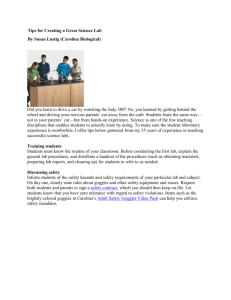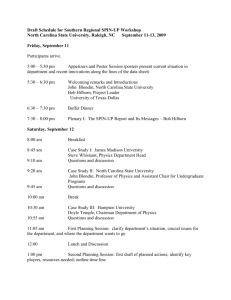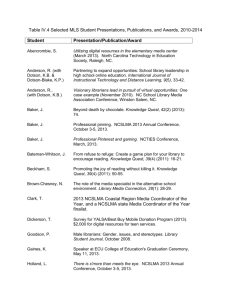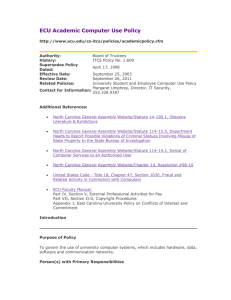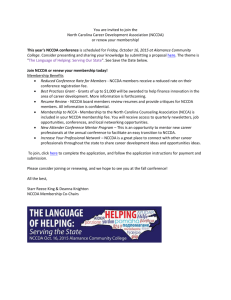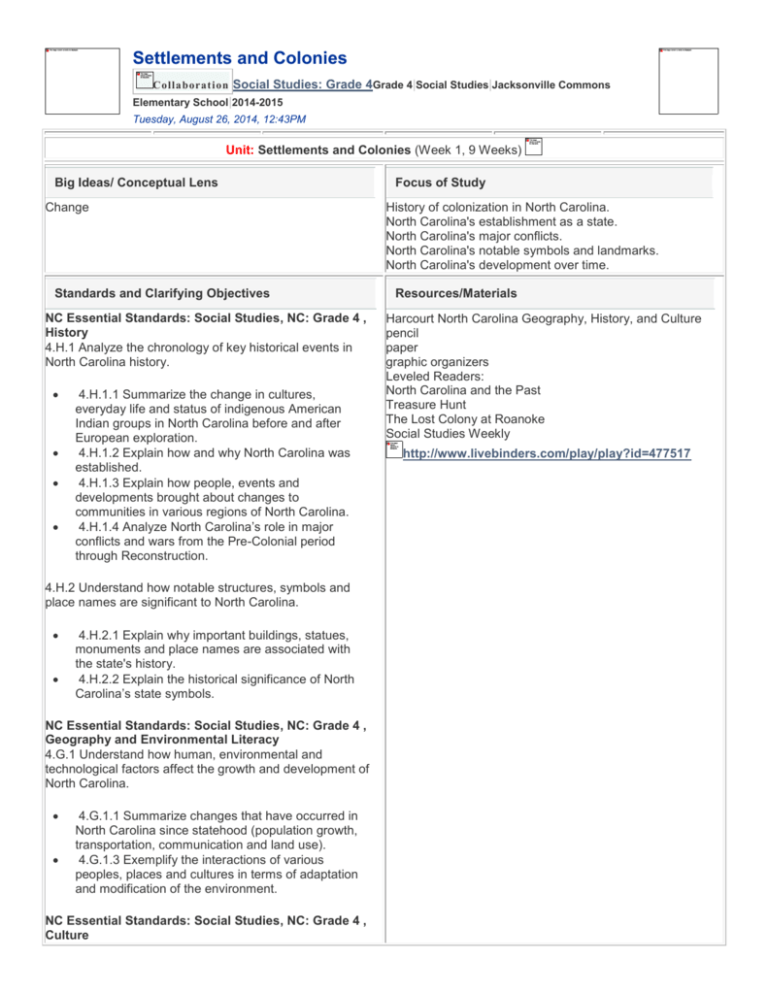
Settlements and Colonies
Col la borat i on Social Studies: Grade 4Grade 4|Social Studies|Jacksonville Commons
Elementary School|2014-2015
Tuesday, August 26, 2014, 12:43PM
Unit: Settlements and Colonies (Week 1, 9 Weeks)
Big Ideas/ Conceptual Lens
Change
Standards and Clarifying Objectives
NC Essential Standards: Social Studies, NC: Grade 4 ,
History
4.H.1 Analyze the chronology of key historical events in
North Carolina history.
4.H.1.1 Summarize the change in cultures,
everyday life and status of indigenous American
Indian groups in North Carolina before and after
European exploration.
4.H.1.2 Explain how and why North Carolina was
established.
4.H.1.3 Explain how people, events and
developments brought about changes to
communities in various regions of North Carolina.
4.H.1.4 Analyze North Carolina’s role in major
conflicts and wars from the Pre-Colonial period
through Reconstruction.
4.H.2 Understand how notable structures, symbols and
place names are significant to North Carolina.
4.H.2.1 Explain why important buildings, statues,
monuments and place names are associated with
the state's history.
4.H.2.2 Explain the historical significance of North
Carolina’s state symbols.
NC Essential Standards: Social Studies, NC: Grade 4 ,
Geography and Environmental Literacy
4.G.1 Understand how human, environmental and
technological factors affect the growth and development of
North Carolina.
4.G.1.1 Summarize changes that have occurred in
North Carolina since statehood (population growth,
transportation, communication and land use).
4.G.1.3 Exemplify the interactions of various
peoples, places and cultures in terms of adaptation
and modification of the environment.
NC Essential Standards: Social Studies, NC: Grade 4 ,
Culture
Focus of Study
History of colonization in North Carolina.
North Carolina's establishment as a state.
North Carolina's major conflicts.
North Carolina's notable symbols and landmarks.
North Carolina's development over time.
Resources/Materials
Harcourt North Carolina Geography, History, and Culture
pencil
paper
graphic organizers
Leveled Readers:
North Carolina and the Past
Treasure Hunt
The Lost Colony at Roanoke
Social Studies Weekly
http://www.livebinders.com/play/play?id=477517
4.C.1 Understand the impact of various cultural groups on
North Carolina.
4.C.1.1 Explain how the settlement of people from
various cultures affected the development of regions
in North Carolina. (languages, foods and traditions)
4.C.1.2 Explain how the artistic expression of
various groups represents the cultural heritage of
North Carolina.
ComCore: ELA & Literacy in History/Social Studies,
Science, & Technical Subjects K-5, ComCore: Grade 4,
Capacities of the Literate Individual
Students Who are College and Career Ready in Reading,
Writing, Speaking, Listening, & Language
They demonstrate independence.
They build strong content knowledge.
They respond to the varying demands of audience,
task, purpose, and discipline.
They comprehend as well as critique.
They value evidence.
They use technology and digital media strategically
and capably.
They come to understand other perspectives and
cultures.
ComCore: ELA & Literacy in History/Social Studies,
Science, & Technical Subjects K-5, ComCore: Grade 4,
Reading: Informational Text
Key Ideas and Details
1. Read closely to determine what the text says explicitly
and to make logical inferences from it; cite specific textual
evidence when writing or speaking to support conclusions
drawn from the text.
RI.4.1. Refer to details and examples in a text when
explaining what the text says explicitly and when
drawing inferences from the text.
3. Analyze how and why individuals, events, and ideas
develop and interact over the course of a text.
RI.4.3. Explain events, procedures, ideas, or
concepts in a historical, scientific, or technical text,
including what happened and why, based on
specific information in the text.
6. Assess how point of view or purpose shapes the content
and style of a text.
RI.4.6. Compare and contrast a firsthand and
secondhand account of the same event or topic;
describe the differences in focus and the information
provided.
Integration of Knowledge and Ideas
7. Integrate and evaluate content presented in diverse
media and formats, including visually and quantitatively, as
well as in words.
RI.4.7. Interpret information presented visually,
orally, or quantitatively (e.g., in charts, graphs,
diagrams, time lines, animations, or interactive
elements on Web pages) and explain how the
information contributes to an understanding of the
text in which it appears.
Range of Reading and Level of Text Complexity
10. Read and comprehend complex literary and
informational texts independently and proficiently.
RI.4.10. By the end of year, read and comprehend
informational texts, including history/social studies,
science, and technical texts, in the grades 4–5 text
complexity band proficiently, with scaffolding as
needed at the high end of the range.
ComCore: ELA & Literacy in History/Social Studies,
Science, & Technical Subjects K-5, ComCore: Grade 4,
Writing
Text Types and Purposes
1. Write arguments to support claims in an analysis of
substantive topics or texts, using valid reasoning and
relevant and sufficient evidence.
W.4.1. Write opinion pieces on topics or texts,
supporting a point of view with reasons and
information.
2. Write informative/explanatory texts to examine and
convey complex ideas and information clearly and
accurately through the effective selection, organization, and
analysis of content.
W.4.2. Write informative/explanatory texts to
examine a topic and convey ideas and information
clearly.
Research to Build and Present Knowledge
7. Conduct short as well as more sustained research
projects based on focused questions, demonstrating
understanding of the subject under investigation.
W.4.7. Conduct short research projects that build
knowledge through investigation of different aspects
of a topic.
8. Gather relevant information from multiple print and digital
sources, assess the credibility and accuracy of each source,
and integrate the information while avoiding plagiarism.
W.4.8. Recall relevant information from experiences
or gather relevant information from print and digital
sources; take notes and categorize information, and
provide a list of sources.
9. Draw evidence from literary or informational texts to
support analysis, reflection, and research.
W.4.9. Draw evidence from literary or informational
texts to support analysis, reflection, and research.
Range of Writing
10. Write routinely over extended time frames (time for
research, reflection, and revision) and shorter time frames (a
single sitting or a day or two) for a range of tasks, purposes,
and audiences.
W.4.10. Write routinely over extended time frames
(time for research, reflection, and revision) and
shorter time frames (a single sitting or a day or two)
for a range of discipline-specific tasks, purposes,
and audiences.
Enduring Understandings
Students understand that politics, economics, culture, and
diversity evolve based on societies current needs.
Students will understand that North Carolina's establishment
and statehood has and will continue over the years.
Students will understand that Americans Indians lived in all
regions of what is present day North Carolina.
Students will understand that American Indian groups used
the natural resources of their region to meet their needs.
Students will understand that each American Indian group
had its own culture and government.
Students will understand that colonists who settled on the
Costal Plain faced attacks from American Indians and
pirates.
Students will understand that pre-colonial North Carolina
became a separate royal colony.
Essential Concepts and Critical Content
Essential Concepts:
diverse
ceremony
confederation
colony
expedition
raw material
cash crops
charter
assembly
tax
royal colony
backcountry
pioneer
treaty
barter
independence
representation
protest
revolution
constitution
bill of rights
culture
change
conflict
cultural heritage
assimilation
interaction
indigenous
European
exploration
political
economic
development
communities
infrastructure
regions of NC
Process Skills
Sequence - Time Lines
compare and contrast
expressing complete thought
discussion
cause and effect
analyze and interpreting - mapsand graphics
drawing conclusions
summarizing
Essential Questions
What American Indian groups were indigenous to North Carolina before and after European exploration? 4.H.1.1
What were the parts of the American Indian group’s culture? 4.H.1.1
What was the European exploration? 4.H.1.1
How did the culture, everyday life, and status of American Indian groups change after the Europeans arrived?
4.H.1.1
What are the regions of North Carolina? 4.H.1.3
What type of development occurs within a community? 4.H.1.3
How did immigration affect the development of N.C. communities? 4.H.1.3, 4.C.1.1
What individuals contributed to the development of N.C.? How did they contribute to the development of N.C.?
4.H.1.3
What cultures contributed to the development of N.C. regions? 4.C.1.1
How did the development of infrastructure change N.C. communities? 4.H.1.3
What national and international events impacted N.C. communities? 4.H.1.3
What is cultural heritage? 4.C.1.2
How does art help share cultural heritage? 4.C.1.2
Integration Opportunities (Optional)
P21: 21st Century Student Outcomes, P21: K-12, Core
Subjects & 21st Century Themes
Global Awareness
Using 21st century skills to understand and address
global issues
Learning from and working collaboratively with
individuals representing diverse cultures, religions
and lifestyles in a spirit of mutual respect and open
dialogue in personal, work and community contexts
Understanding other nations and cultures, including
the use of non-English languages
Financial, Economic, Business and Entrepreneurial Literacy
Understanding the role of the economy in society
P21: 21st Century Support Systems, P21: K-12, 21st
Century Support Systems
21st Century Standards
Focuses on 21st century skills, content knowledge
and expertise.
Emphasizes deep understanding rather than
shallow knowledge
Assessment of 21st Century Skills
Supports a balance of assessments, including highquality standardized testing along with effective
Additional Integration Opportunities (Optional)
Opinion Polls
Graphing
Narrative Writing Responses
Elapsed Time
Description Writing
Calculate travel time with past modes of transportation
Dance, Song and Folk-art
Persuasion Writing Responses
classroom formative and summative assessments
Character Qualities (Optional)
Respect
Self-discipline
Caring
Responsibility
Cooperation
Citizenship
Differentiation/Intervention Focus Areas (Optional
Leveled Text
Formative, Interim, and Summative Assessments
Unit 2 Settlements and Colonies
Summative: Test: Unit
Lessons
Informal: Other: Quiz
Professional Teaching Standards
NC Professional Teaching Standards, All Levels, Professional Teaching Standards
STANDARD I: TEACHERS DEMONSTRATE
LEADERSHIP
Teachers lead in their classrooms.
Teachers demonstrate leadership in the school.
Teachers lead the teaching profession.
Teachers advocate for schools and students.
Teachers demonstrate high ethical standards.
STANDARD II: TEACHERS ESTABLISH A RESPECTFUL ENVIRONMENT FOR
A DIVERSE POPULATION OF STUDENTS
Teachers provide an environment in which each child has a positive,
nurturing relationship with caring adults.
Teachers embrace diversity in the school community and in the world.
Teachers treat students as individuals.
Teachers adapt their teaching for the benefit of students with
special needs.
Teachers work collaboratively with the families and significant adults
in the lives of their students.
STANDARD III: TEACHERS KNOW THE CONTENT THEY TEACH
Teachers align their instruction with the North Carolina Standard Course of Study.
Teachers know the content appropriate to their teaching specialty.
Teachers recognize the interconnectedness of content areas/disciplines.
STANDARD IV: TEACHERS FACILITATE LEARNING FOR THEIR STUDENTS
Teachers know the ways in which learning takes place, and they know
the appropriate levels of intellectual, physical, social, and emotional
development of their students.
Teachers plan instruction appropriate for their students.
Teachers use a variety of instructional methods.
Teachers integrate and utilize technology in their instruction.
Teachers help students develop critical thinking and problemsolving skills.
Teachers help students work in teams and develop leadership qualities.
Teachers communicate effectively.
Teachers use a variety of methods to assess what each student has learned.
STANDARD V: TEACHERS REFLECT ON THEIR PRACTICE
Teachers analyze student learning.
Teachers link professional growth to their professional goals.
Teachers function effectively in a complex, dynamic environment.
<< Previous Year
Last Updated: Tuesday, August 26, 2014, 12:41PM
Atlas Version 8.0.4
© Rubicon International 2014. All rights reserved


